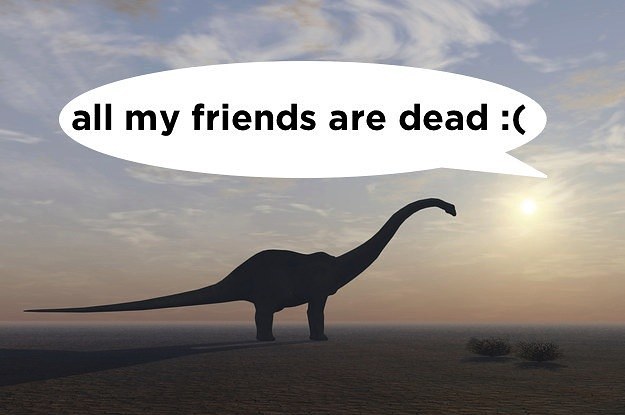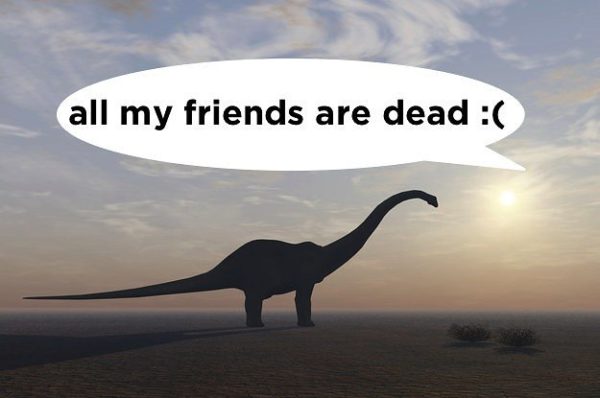
24 Sep What Really Happened to the Dinosaurs
How about dinosaurs as a distraction from the noisy, noisome headlines? No, not the old white guys in Congress – the ancient relatives of the ones that populated Jurassic Park. Curious about how they met their maker? This story by Bianca Bosker for The Atlantic is an eye-opener.

Gerta Keller was waiting for me at the Mumbai airport so we could catch a flight to Hyderabad and go hunt rocks. “You won’t die,” she told me cheerfully as soon as I’d said hello. “I’ll bring you back.”
Death was not something I’d considered as a possible consequence of traveling with Keller, a 73-year-old paleontology and geology professor at Princeton University. She looked harmless enough: thin, with a blunt bob, wearing gray nylon pants and hiking boots, and carrying an insulated ShopRite supermarket bag by way of a purse.
I quickly learned that Keller felt such reassurances were necessary because, appropriately for someone who studies mass extinctions, she has a tendency to attract disaster. Long before our 90-minute flight touched down, she’d told me about having narrowly escaped death four times—once while attempting suicide, once from hepatitis contracted during an Algerian coup, once from getting shot in a robbery gone wrong, and once from food poisoning in India—and this was by no means an exhaustive list. She has crisscrossed dozens of countries doing field research and can claim near-death experiences in many of them: with a jaguar in Belize, a boa in Madagascar, a mob in Haiti, an uprising in Mexico.
Keller had vowed not to return to India after the food-poisoning debacle. But, never one to avoid calamity, she’d traveled to Mumbai—and gotten sick before her plane had even landed; an in-flight meal had left her retching. Keller was in India to research a catastrophe that has consumed her for the past 30 years: the annihilation of three-quarters of the Earth’s species—including, famously, the dinosaurs—during our planet’s most recent mass extinction, about 66 million years ago. She would be joined in Hyderabad by three collaborators: the geologists Thierry Adatte, from the University of Lausanne; Syed Khadri, from Sant Gadge Baba Amravati University, in central India; and Mike Eddy, also from Princeton. They picked us up at the airport in a seat-belt-less van manned by a driver who looked barely out of his teens, and we began the five-hour drive to our hotel in a town so remote, I hadn’t confidently located it on a map.
Where I looked out our van’s window at a landscape of skeletal cows and chartreuse rice paddies, Keller saw a prehistoric crime scene. She was searching for fresh evidence that would help prove her hypothesis about what killed the dinosaurs—and invalidate the asteroid-impact theory that many of us learned in school as uncontested fact. According to this well-established fire-and-brimstone scenario, the dinosaurs were exterminated when a six-mile-wide asteroid, larger than Mount Everest is tall, slammed into our planet with the force of 10 billion atomic bombs. The impact unleashed giant fireballs, crushing tsunamis, continent-shaking earthquakes, and suffocating darkness that transformed the Earth into what one poetic scientist described as “an Old Testament version of hell.”
Before the asteroid hypothesis took hold, researchers had proposed other, similarly bizarre explanations for the dinosaurs’ demise: gluttony, protracted food poisoning, terminal chastity, acute stupidity, even Paleo-weltschmerz—death by boredom. These theories fell by the wayside when, in 1980, the Nobel Prize–winning physicist Luis Alvarez and three colleagues from UC Berkeley announced a discovery in the journal Science. They had found iridium—a hard, silver-gray element that lurks in the bowels of planets, including ours—deposited all over the world at approximately the same time that, according to the fossil record, creatures were dying en masse. Mystery solved: An asteroid had crashed into the Earth, spewing iridium and pulverized rock dust around the globe and wiping out most life forms.
Their hypothesis quickly gained traction, as visions of killer space rocks sparked even the dullest imaginations. nasa initiated Project Spacewatch to track—and possibly bomb—any asteroid that might dare to approach. Carl Sagan warned world leaders that hydrogen bombs could trigger a catastrophic “nuclear winter” like the one caused by the asteroid’s dust cloud. Science reporters cheered having a story that united dinosaurs and extraterrestrials and Cold War fever dreams—it needed only “some sex and the involvement of the Royal Family and the whole world would be paying attention,” one journalist wrote. News articles described scientists rallying around Alvarez’s theory in record time, especially after the so-called impacter camp delivered, in 1991, the geologic equivalent of DNA evidence: the “Crater of Doom,” a 111-mile-wide cavity near the Mexican town of Chicxulub, on the Yucatán Peninsula. Researchers identified it as the spot where the fatal asteroid had punched the Earth. Textbooks and natural-history museums raced to add updates identifying the asteroid as the killer.
The impact theory provided an elegant solution to a prehistoric puzzle, and its steady march from hypothesis to fact offered a heartwarming story about the integrity of the scientific method. “This is nearly as close to a certainty as one can get in science,” a planetary-science professor told Time magazine in an article on the crater’s discovery. In the years since, impacters say they have come even closer to total certainty. “I would argue that the hypothesis has reached the level of the evolution hypothesis,” says Sean Gulick, a research professor at the University of Texas at Austin who studies the Chicxulub crater. “We have it nailed down, the case is closed,” Buck Sharpton, a geologist and scientist emeritus at the Lunar and Planetary Institute, has said.
But Keller doesn’t buy any of it. “It’s like a fairy tale: ‘Big rock from sky hits the dinosaurs, and boom they go.’ And it has all the aspects of a really nice story,” she said. “It’s just not true.”
While the majority of her peers embraced the Chicxulub asteroid as the cause of the extinction, Keller remained a maligned and, until recently, lonely voice contesting it. She argues that the mass extinction was caused not by a wrong-place-wrong-time asteroid collision but by a series of colossal volcanic eruptions in a part of western India known as the Deccan Traps—a theory that was first proposed in 1978 and then abandoned by all but a small number of scientists. Her research, undertaken with specialists around the world and featured in leading scientific journals, has forced other scientists to take a second look at their data. “Gerta uncovered many things through the years that just don’t sit with the nice, simple impact story that Alvarez put together,” Andrew Kerr, a geochemist at Cardiff University, told me. “She’s made people think about a previously near-uniformly accepted model.”
Keller’s resistance has put her at the core of one of the most rancorous and longest-running controversies in science. “It’s like the Thirty Years’ War,” says Kirk Johnson, the director of the Smithsonian’s National Museum of Natural History. Impacters’ case-closed confidence belies decades of vicious infighting, with the two sides trading accusations of slander, sabotage, threats, discrimination, spurious data, and attempts to torpedo careers. “I’ve never come across anything that’s been so acrimonious,” Kerr says. “I’m almost speechless because of it.” Keller keeps a running list of insults that other scientists have hurled at her, either behind her back or to her face. She says she’s been called a “bitch” and “the most dangerous woman in the world,” who “should be stoned and burned at the stake.”
Understanding the cause of the mass extinction is not an esoteric academic endeavor. Dinosaurs are what paleontologists call “charismatic megafauna”: sexy, sympathetic beasts whose obliteration transfixes pretty much anyone with a pulse. The nature of their downfall, after 135 million years of good living, might offer clues for how we can prevent, or at least delay, our own end. “Without meaning to sound pessimistic,” the geophysicist Vincent Courtillot writes in his book Evolutionary Catastrophes, “I believe the ancient catastrophes whose traces geologists are now exhuming are worthy of our attention, not just for the sake of our culture or our understanding of the zigzaggy path that led to the emergence of our own species, but quite practically to understand how to keep from becoming extinct ourselves.”
This dispute illuminates the messy way that science progresses, and how this idealized process, ostensibly guided by objective reason and the search for truth, is shaped by ego, power, and politics. Keller has had to endure decades of ridicule to make scientists reconsider an idea they had confidently rejected. “Gerta had to fight very much to get into the position that she is in right now,” says Wolfgang Stinnesbeck, a collaborator of Keller’s from Heidelberg University. “It’s thanks to her that the case is not closed.”
Over the course of its 4.5-billion-year existence, the Earth has occasionally lashed out against its inhabitants. At five different times, mass extinctions ensued…
Read on for the whole, umm, jaw-dropping story… (Get it, dinosaurs, jaws…?)


Sorry, the comment form is closed at this time.